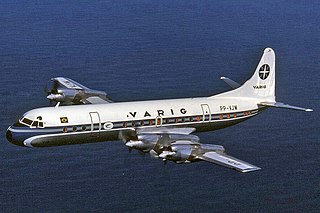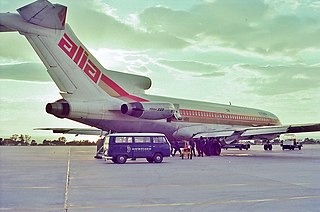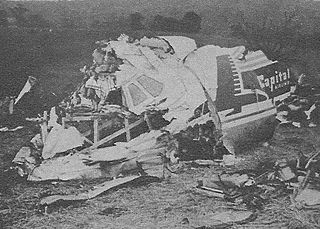
The Airspeed AS.57 Ambassador is a British twin piston-engined airliner that was designed and produced by the British aircraft manufacturer Airspeed Ltd. It was one of the first postwar airliners to be produced.

The Vickers Viscount is a British medium-range turboprop airliner first flown in 1948 by Vickers-Armstrongs. A design requirement from the Brabazon Committee, it entered service in 1953 and was the first turboprop-powered airliner.

The Vickers Vanguard was a short/medium-range turboprop airliner designed and produced by the British aircraft manufacturer Vickers-Armstrongs.
Transportes Aereos del Continente Americano,, operating as Avianca El Salvador, is an airline owned by Kingsland Holdings based in El Salvador. As TACA, it still currently operates as the flag carrier of El Salvador. As Avianca El Salvador, it is one of the seven national branded airlines in the Avianca Group of Latin American airlines, and has been in operation for 75 years.

The Lockheed L-188 Electra is an American turboprop airliner built by Lockheed. First flown in 1957, it was the first large turboprop airliner built in the United States. Initial sales were good, but after two fatal crashes that led to expensive modifications to fix a design defect, no more were ordered. With its unique high power-to-weight ratio, huge propellers and very short wings, large Fowler flaps which significantly increased effective wing area when extended, and four-engined design, the airplane had airfield performance capabilities unmatched by many jet transport aircraft even today—particularly on short runways and high field elevations. Jet airliners soon supplanted turboprops for many purposes, and many Electras were modified as freighters. Some Electras are still being used in various roles into the 21st century. The airframe was also used as the basis for the Lockheed P-3 Orion maritime patrol aircraft.

Air Rhodesia was the national airline of Rhodesia. Its head office was located on the property of Salisbury Airport in Salisbury.

Capital Airlines was an airline serving the eastern, southern, southeastern, and midwestern United States. Capital's headquarters were located at Washington National Airport across the Potomac river from Washington, D.C., where crew training and aircraft overhauls were also accomplished. In the 1950s Capital was the fifth largest United States domestic carrier by passenger count after the Big Four air carriers.
Africa Safari Airways was an airline based in Mombasa, Kenya. It operated charter flights and inclusive tours beginning in 1967 from Europe, mainly to Mombasa. Its main base was Moi International Airport, Mombasa. It ceased operations in 2009.
Intercontinental de Aviación S.A. was an airline based in Bogotá, Colombia. It operated domestic services and flights to neighboring countries. Its main hub was located at El Dorado International Airport in Bogotá, with a secondary hub at Alfonso Bonilla Aragón International Airport in Cali. The airline closed operations in 2005.

United Air Lines Flight 297 was a scheduled flight from Newark International Airport to Atlanta that crashed 10 miles (16 km) southwest of Baltimore on November 23, 1962, killing all 17 people on board. An investigation concluded that the aircraft, a Vickers Viscount 745D turboprop airliner, had struck at least two whistling swans, which caused severe damage to the plane, resulting in a loss of control.

Trans-Canada Air Lines Flight 304 was operated by a Vickers Viscount 700 aircraft owned by Trans-Canada Air Lines. On July 9, 1956, the No. 4 propeller of the aircraft tore loose from its engine over Flat Rock, Michigan in the United States, during a flight from Chicago, Illinois, to Toronto, Ontario, and Montreal, Quebec; one blade of the propeller sliced through the passenger section of the cabin, killing one passenger and injuring four passengers and one flight attendant. The aircraft diverted to Windsor, Ontario, in Canada, and the pilots carried out an emergency landing. The accident was the first to involve a Vickers Viscount aircraft in scheduled service, and was the first instance of a propeller loss on a turbo-prop aircraft.
Central African Airways (CAA) was a supranational airline corporation serving as flag carrier for Southern Rhodesia, Northern Rhodesia and Nyasaland, which were organised as the Federation of Rhodesia and Nyasaland, also known as the Central African Federation, from 1953 to 1963. Based in Salisbury, it offered an extensive network of domestic passenger and cargo flights, as well as international services to major cities in Southern and Central Africa, and a route to London. In 1960, CAA owned 15 aircraft and had 1,155 employees.

Cambrian Airways was an airline based in the United Kingdom which ran operations from Cardiff Airport and Liverpool John Lennon Airport between 1935 and 1974. It was incorporated into British Airways when BOAC, BEA, Cambrian and Northeast merged on 1 April 1974.

Austrian Airlines Flight 901 was a flight from Vienna, Austria to Moscow, USSR via Warsaw, Poland. On the night of 26 September 1960 the aircraft operating the flight, a Vickers Viscount, crashed near Moscow while on its approach to land, killing 31 of the 37 passengers and crew on board.

Aeropesca Colombia Flight 217 was an internal scheduled passenger flight in Colombia from La Vanguardia Airport, Villavicencio to El Dorado International Airport, Bogotá. On 26 March 1982 the flight was operated by a four-engined Vickers Viscount turboprop registered HK-2382 which collided with a mountain at 7,700 feet 130 km south east from Bogotá near Quetame in bad weather. The storm hampered rescue attempts. All 21 on board were killed.

The TABA Fairchild FH-227 accident happened on 12 June 1982 when a twin-engined Fairchild FH-227B on an internal scheduled passenger flight from Eirunepé Airport to Tabatinga International Airport crashed in bad weather. On approach to land at Tabatinga, the aircraft hit a lighting tower and crashed into a car park; the aircraft exploded and burned, and all 44 on board were killed.

Alia Royal Jordanian Flight 600 was a scheduled passenger flight from Queen Alia International Airport, Jordan to Seeb International Airport, Muscat, Oman, via Doha International Airport in Qatar. On 14 March 1979 it was being operated by a Boeing 727-2D3 jet airliner registered in Jordan as JY-ADU when, while carrying out a missed approach to Runway 34 at Doha at night, it flew into a thunderstorm, causing the aircraft to drop 750 feet (230 m) into the ground. Sixty-four people were on board; of the 15 crew four died and two were seriously injured and 41 passengers were killed and six seriously injured; the aircraft was destroyed.

Olympic Airways Flight 830 was a domestic scheduled passenger flight in Greece from Athens to Kozani with a stop in Larisa. On 23 November 1976 it was being operated by a NAMC YS-11A turboprop airliner registered in Greece as SX-BBR when it collided at an altitude of 4,625 feet (1,410 m) with a mountain near Servia and crashed, killing all 50 on board.

On May 20, 1958 a Vickers Viscount airliner operating Capital Airlines Flight 300 was involved in a mid-air collision with a United States Air Force T-33 jet trainer on a proficiency flight in the skies above Brunswick, Maryland. All 11 people on board the Viscount and one of the two crew in the T-33 were killed in the accident.















